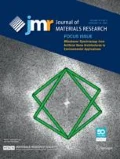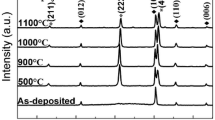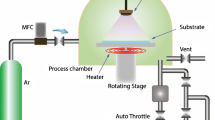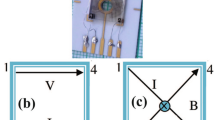Abstract
The thermal degradation behavior of indium tin oxide (ITO) thin films coated on glass substrates using radio frequency (rf) magnetron sputtering was investigated over the temperature range of 100–400 °C in air. The resistivity of ITO films increases abruptly after the thermal degradation temperature of 250 °C is reached, with a slight increase from 200 to 250 °C. The x-ray photoelectron spectrometry intensity ratio of O/(In + Sn) in thermally degraded ITO films is higher than that in normal films. The carrier concentration gradually decreases up to 200 °C, sharply drops between 200 and 250 °C with increasing temperature, and then saturates from 275 °C. The Hall mobility drops suddenly at 275 °C. The diffusion of oxygen into oxygen interstitials and oxygen vacancies and the chemisorption of oxygen into grain boundaries decrease the carrier concentration and the Hall mobility, respectively. The former mainly affects the resistivity of ITO films below 250 °C, and the later above 250 °C.
Similar content being viewed by others
References
H. Ohsaki and Y. Kokubu: Global market and technology trends on coated glass for architectural, automotive and display applications. Thin Solid Films 351, 1 (1999).
K.L. Chopra, S. Major, and D.K. Pandya: Transparent conductors— A status review. Thin Solid Films 102, 1 (1983).
J. He, M. Lu, X. Zhou, J.R. Cao, K.L. Wang, L.S. Liao, Z.B. Deng, X.M. Ding, X.Y. Hou, and S.T. Lee: Damage study of ITO under high electric field. Thin Solid Films 363, 240 (2000).
J.C. Scott, J.H. Kaufman, P.J. Brock, R. DiPietro, J. Salem, and J.A. Goitia: Degradation and failure of MEH-PPV light-emitting diodes. J. Appl. Phys. 79, 2745 (1996).
C.I. Chao, K.R. Chuang, and S.A. Chen: Failure phenomena and mechanisms of polymeric light-emitting diodes: Indium–tin–oxide damage. Appl. Phys. Lett. 69, 2894 (1996).
C. Adachi, K. Nagai, and N. Tamoto: Molecular design of hole transport materials for obtaining high durability in organic electroluminescent diodes. Appl. Phys. Lett. 66, 2679 (1995).
Y. Shigesato and D.C. Paine: A microstructural study of low resistivity tin-doped indium oxide prepared by d.c. magnetron sputtering. Thin Solid Films 238, 44 (1994).
H. Tomonaga and T. Morimoto: Indium-tin oxide coatings via chemical solution deposition. Thin Solid Films 392, 243 (2001).
S.M. Goodnick, J.F. Wager, and C.W. Wilmsen: Thermal degradation of indium-tin-oxide/p-silicon solar cells. J. Appl. Phys. 51, 527 (1980).
G. Frank and H. Köstlin: Electrical properties and defect model of tin-doped indium oxide layers. Appl. Phys. A 27, 197 (1982).
G.B. González, T.O. Mason, J.P. Quintana, O. Warschkow, D.E. Ellis, J.H. Hwang, J.P. Hodges, and J.D. Jorgensen: Defect structure studies of bulk and nano-indium-tin oxide. J. Appl. Phys. 96, 3912 (2004).
M. Mizuhashi: Lamellar and grain boundary models for the electrical properties of post-oxidized ITO films. Jpn. J. Appl. Phys. 22, 615 (1983).
T. Minami: New n-type transparent conducting oxides. MRS Bull. 25, 38 (2000).
A. Gupta, P. Gupta, and V.K. Srivastava: Annealing effects in indium oxide films prepared by reactive evaporation. Thin Solid Films 123, 325 (1985).
O.P. Agnihotri, A.K. Sharma, B.K. Gupta, and R. Thangaraj: The effect of tin additions on indium oxide selective coatings. J. Phys. D: Appl. Phys. 11, 643 (1978).
J. Bhattacharyya, S. Chaudhuri, D. De, and A.K. Pal: Preparation and characterization of indium tin oxide films produced by the d.c. sputtering technique. Thin Solid Films 128, 231 (1985).
K. Adachi, T. Hirayama, and H. Sakata: The effect of gas atmospheres on resistivity of indium tin oxide films at high temperature. J. Mater. Sci. 25, 1403 (1990).
Author information
Authors and Affiliations
Corresponding author
Rights and permissions
About this article
Cite this article
Kim, YN., Shin, HG., Song, JK. et al. Thermal degradation behavior of indium tin oxide thin films deposited by radio frequency magnetron sputtering. Journal of Materials Research 20, 1574–1579 (2005). https://doi.org/10.1557/JMR.2005.0199
Received:
Accepted:
Published:
Issue Date:
DOI: https://doi.org/10.1557/JMR.2005.0199




